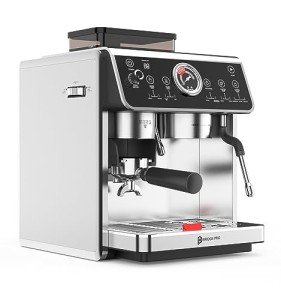Home Use Espresso Machines: A Comprehensive Guide
Espresso machines have ended up being a staple in lots of homes as coffee lovers look for to duplicate café-quality brews in the convenience of their kitchens. The rise in appeal has actually caused a diverse market filled with numerous models, features, and rates. This article intends to provide an informative overview of home use espresso machines, helping readers navigate their alternatives successfully.
Comprehending Espresso Machines
Espresso machines work by requiring warm water through finely-ground coffee under high pressure, leading to a concentrated coffee drink referred to as espresso. There are several types of espresso machines classified based on their developing methods and level of automation. The most common types include:
- Manual Espresso Machines: These need the user to control the pressure and water circulation, permitting a more hands-on coffee-making experience.
- Semi-Automatic Espresso Machines: These use automatic control over water pressure, while the user by hand grinds and tamps the coffee.
- Automatic Espresso Machines: With the push of a button, these machines immediately control the circulation of water, making it easier to brew espresso with consistent results.
- Super-Automatic Espresso Machines: These all-in-one machines deal with grinding, tampering, developing, and even milk frothing, making them ideal for users searching for convenience.
- Capsule or Pod Machines: These use pre-packaged coffee pods to produce espresso with minimal effort, but they restrict choice in developing methods and flavors.
Table: Comparison of Espresso Machine Types
| Type | Control Level | Ease of Use | Cleaning up Level | Suitable For |
|---|---|---|---|---|
| Manual | User-controlled | Moderate | High | Coffee purists |
| Semi-Automatic | Partial automation | Moderate | Moderate | Home baristas |
| Automatic | Completely automated | Easy | Low | Hectic individuals |
| Super-Automatic | Fully automated | Extremely easy | Extremely low | Convenience hunters |
| Capsule/Pod | Fully automated | Extremely simple | Extremely low | Casual drinkers |
Secret Features to Consider
When choosing a home use espresso machine, it's necessary to consider various features that can substantially impact the quality of espresso and user experience.
- Pressure: Look for machines that supply a minimum of 9 bars of pressure, as this is considered ideal for brewing espresso.
- Boiler Systems: Single vs. dual boiler systems determine temperature level stability and the capability to brew espresso and steam milk at the same time.
- Grinder: Integrated mills allow for freshly ground coffee, which improves taste. Think about machines with adjustable grind settings.
- Milk Frother: For those who take pleasure in cappuccinos and lattes, a built-in steam wand or automatic frother is crucial.
- Size and Design: Consider your cooking area space and aesthetic choices. Click At this website come in different sizes, from compact to large setups.
- Price: Home espresso machines can vary from a few hundred to several thousand dollars, so it's crucial to establish a budget before checking out choices.
Benefits and drawbacks of Home Use Espresso Machines
| Pros | Cons |
|---|---|
| Benefit of brewing coffee at home | Preliminary investment can be high |
| Quality of espresso is frequently exceptional | Needs some ability, particularly with manual machines |
| Capability to explore tastes | Upkeep and cleaning can be labor-intensive |
| Can save money in the long run | Not all machines will match every coffee choice |
Upkeep and Cleaning Tips
Preserving an espresso machine is essential for extending its life and ensuring constant brew quality. Here are some useful ideas:
- Regular Descaling: Minerals from water can develop in the machine. Descale every 1-3 months, depending on water solidity.
- Daily Cleaning: Rinse portafilters, baskets, and steam wands after each use to avoid coffee oils from developing residue.
- Use Filtered Water: This can help in reducing mineral buildup and improve the taste of coffee.
- Replace Gaskets and Seals: These components may wear out in time and needs to be changed to keep pressure and performance.
- Read the Manual: Each machine has particular care instructions; following these will make sure longevity.
FAQs About Home Use Espresso Machines
Q1: What is the very best budget espresso machine?The best budget espresso machine often depends upon private needs, however designs like the DeLonghi EC155 or the Breville Bambino are popular among users for providing fantastic worth. Q2: How long do home espresso machines typically last?With appropriate upkeep, home espresso machines can last anywhere from 5 to 15 years, depending upon the quality of the machine and frequency of use. Q3: Can I make cappuccinos and lattes with any espresso machine?While most espresso machines can make cappuccinos and lattes, having a reliable
steam wand or frother is necessary for accomplishing the ideal milk texture.
Q4: Are super-automatic machines worth the investment?For those who prioritize convenience and quick brewing, super-automatic machines can be worth the investment, though they may lack some customizability in brew strength and flavor. Discounted Espresso Machines : What types of coffee beans are best for espresso?While individual preference plays a role, beans identified as" espresso "blends are typically roasted darker, developing rich tastes and a velvety texture when brewed.
Investing in a home espresso machine can transform the day-to-day coffee routine into something special, raising home brews to café quality. By understanding the various kinds of machines, key features to consider, upkeep requirements, and weighing the
pros and cons, customers can make informed decisions that match their private preferences. As the espresso culture continues to grow, no matter the option, every brew can be a delicious experience waiting to be relished.

